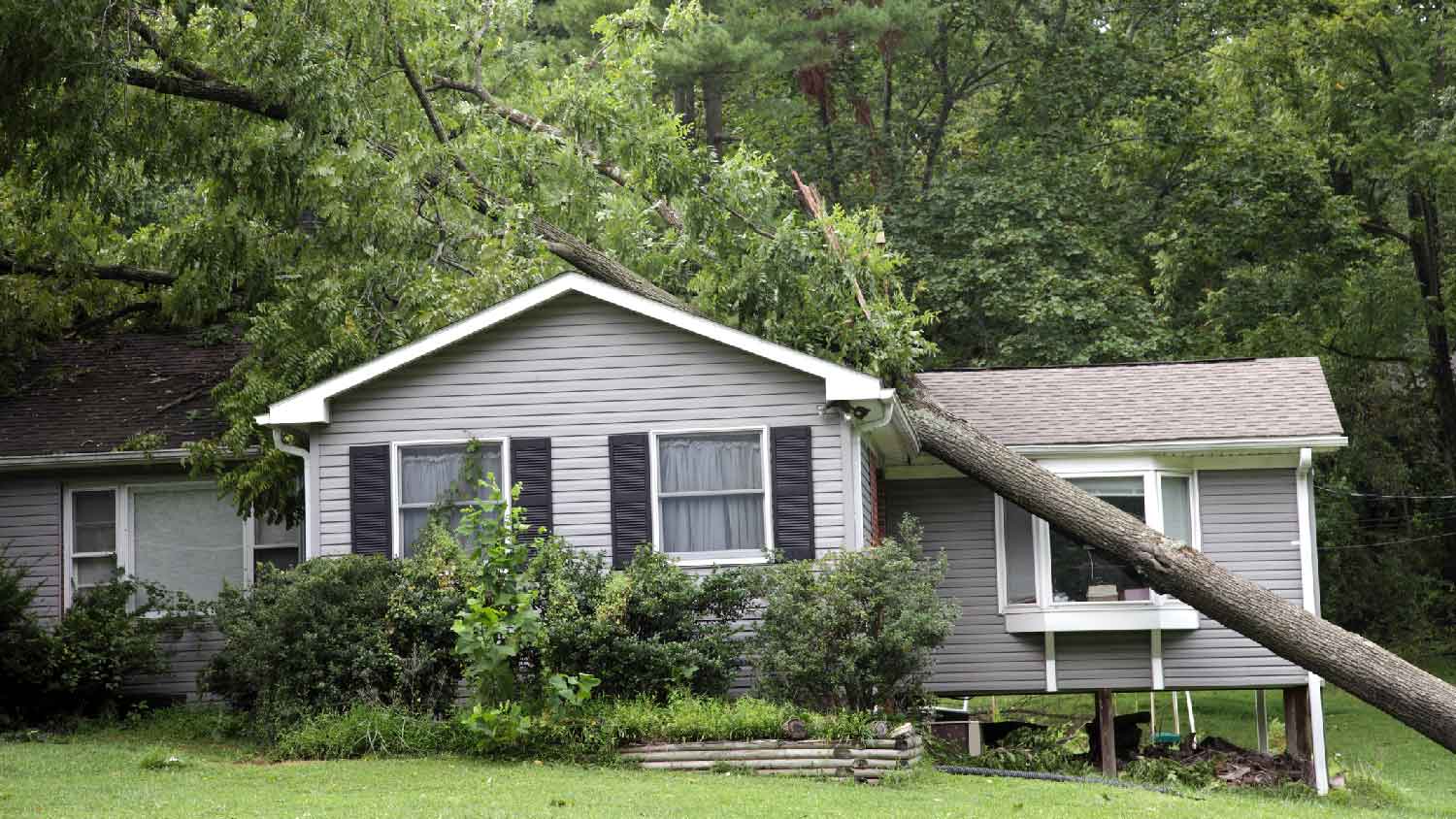
Tree inspections can ensure your trees stay healthy and safe, preventing costly damage. Learn how much tree inspections cost and what can affect the price.
Here's what's next when a tree hits the house


A tree falling on a house is one of the most common causes of tree damage.
When a tree strikes a home, your personal safety should be prioritized over fixing or documenting the issue.
Most types of tree damage to houses are covered by homeowners insurance.
Tree roots hitting foundations or pipes can also cause significant damage.
On average, tree damage repair costs $750.
If a tree or tree limb has just struck your house, you may be wondering what comes next. The danger isn't necessarily gone just because the event is over. Here's a look at the steps to follow to stay safe and get the situation taken care of following tree damage to the house.
If the tree damage is serious enough to compromise your roof or cause an opening in your home, you should strongly consider evacuating. If the damage appears minor, you should at least stay away from the area of the home that has been struck. The next step is to determine if power lines were affected. While you shouldn't approach the area to investigate, you should contact emergency services immediately if you suspect that downed power lines or fire risks are present.
Once you're in a safe location, the next priority is to contact your homeowners' insurance company to get started on a claim right away. If it is safe to do so, you can document the damage using photographs or video. However, you should not attempt to get footage if it puts your safety at risk.
If tree damage has left your home uninhabitable, you'll need to make arrangements to stay somewhere safe. Of course, not everyone has friends or family waiting in the wings to take them in. This is why it's a good idea to ask your insurance agent if your policy provides coverage for temporary housing due to house damage.
If you decide to take photographs or video footage, you should not disturb the scene in any way. Altering the scene could jeopardize your chances of being reimbursed for damage. Your insurance company will be sending out an adjuster to assess the damage shortly. When they arrive, they need to see the damage in its original state in order to estimate costs.

If tree damage has created an unsafe situation on your property, you'll need to make sure that neighbors or delivery professionals don't unknowingly approach your property. Seal off any dangerous areas with tape to prevent entry. You can also consider putting up "Do Not Enter" signs in front of your driveway or walkway. If windows or doors have been busted as a result of the tree damage, get them boarded up to prevent further damage. Exposed entryways could also encourage theft or vandalism if they are not covered.
If the tree that caused the damage is located on your property, you will be liable for the damage. However, you may have trouble getting damages covered by your insurance company if the tree is dead, diseased, or improperly maintained. If the tree that damaged your property is located on a neighboring property, another party may be liable. The complexity of laws and regulations regarding tree damage makes seeking legal guidance a smart idea if you believe there could be nuances in your specific situation.
Following tree damage, most homeowners will need professional tree removal services to remove parts of the tree that impacted the home. In addition, the remaining tree trunk or stump may need to be removed and ground. Local tree debris removal experts can safely remove trees and tree parts while helping homeowners navigate the complexities of homeowners insurance claims. While the average tree removal cost is $750, prices can range from $200 to $2,000 for different tree sizes and species.
While a tree falling on a house is the most dramatic type of tree damage to the house, there are actually many other ways that trees can cause chaos on your property. Can tree roots damage foundation? Yes, this is a common problem that can happen when trees are planted too close to homes. While tree roots will sometimes redirect around or over foundations, they may also take advantage of cracks to push up against foundations. It's also common to find tree roots in pipes when roots take advantage of leaks or cracks to push forward.
From average costs to expert advice, get all the answers you need to get your job done.

Tree inspections can ensure your trees stay healthy and safe, preventing costly damage. Learn how much tree inspections cost and what can affect the price.
Get transparent shrub removal cost info. Learn average prices, key cost factors, and tips to save on your next shrub removal project.

How much does it cost to rent a chainsaw? Whether it’s for cleaning up your yard or cutting firewood, learn what options are available and what you’ll pay.

Unattended bushes and shrubs can quickly become overgrown and start causing problems. Rein them back in with our overgrown shrub trimming guide.

Palm tree stumps can be an eyesore and may even attract pests. Learn the four methods for palm tree stump removal in this DIY guide.

Trimming shrubs and bushes takes time, patience, and a little sweat equity. Our guide will show you how to trim shrubs and bushes properly.